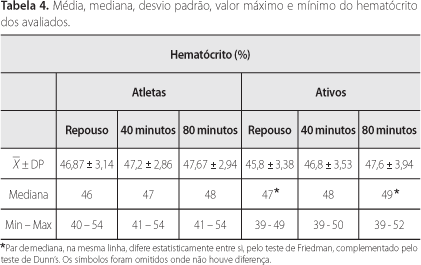The objective was to evaluate the influence of the level of physical conditioning on the hydration status and the efficiency of the intake of 3 mL of water / kg of body weight to maintain the euhydration of athletes or healthy active individuals. Two groups of subjects consisting of 15 male athletes {VO2max 68 ± 5.4 mL (kg.min)-1} and 15 healthy active male subjects {VO2max 50.3 ± 6.3 mL (kg.min)-1} were evaluated. The hydration status was diagnosed through monitoring of body weight, specific gravity of the urine and the hematocrit during 80 minutes of treadmill running. 3 mL of water / kg of body weight were drunk during the activity. The environmental conditions of the test were 21.9 + 1.5 °C and 89.2 ± 5.6 % relative air humidity (RAH) for the athletes and 21.8 ± 1.6°C and 93.2 ± 3.5 % RAH for the active subjects. The average percentage of dehydration and the relative weight loss were significantly greater in the athletes (2.15 ± 0.7 % and 1.3 ± 0.5 kg), compared to the active subjects (1.03 ± 0.7 % and 0.74 ± 0.43 kg), respectively. The specific gravity of the urine increased significantly only in the athletes, while the hematocrit did not vary significantly between groups. Considering the conditions of the test, it was concluded that the higher level of conditioning allowed a lower hydration status and that, although the hydric loss had not reached critical levels, the strategy of hydration utilizing 3 mL of water / kg of body weight was not sufficient to maintain the subjects here completely euhydrated.
dehydration; hydration; hematocrit; weight loss




